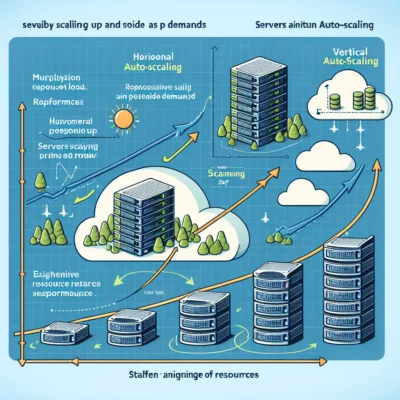In today’s digital age, businesses are increasingly turning to cloud computing to meet their IT needs. One of the most powerful features of cloud computing is auto-scaling, a technology that allows businesses to dynamically adjust their computing resources based on demand. This blog will explore the intricacies of auto-scaling, its cost and performance benefits, and how businesses can implement it effectively.
Understanding Auto-Scaling Technology
Auto-scaling is a cloud computing feature that automatically adjusts the number of active servers or resources based on current demand. It plays a crucial role in ensuring that applications have the necessary resources to perform efficiently without overspending on unused capacity.
The Mechanics of Auto-Scaling
Auto-scaling works by monitoring key performance indicators (KPIs) such as CPU usage, memory consumption, and network traffic. When these metrics reach predefined thresholds, the system either adds more resources (scaling out) or reduces them (scaling in). This dynamic adjustment helps maintain optimal performance and cost-efficiency.
Types of Auto-Scaling
There are two primary types of auto-scaling: horizontal and vertical.
- Horizontal Scaling (Scaling Out/In): This involves adding or removing instances of a resource. For example, if an application experiences a surge in traffic, more instances are launched to handle the load.
- Vertical Scaling (Scaling Up/Down): This involves adding more power (CPU, RAM) to an existing instance. It’s ideal for applications that require more resources but cannot be distributed across multiple instances.
Cost Optimization Through Auto-Scaling
One of the most compelling benefits of auto-scaling is its ability to optimize costs. By adjusting resources based on real-time demand, businesses can avoid the expense of maintaining unused capacity.
Reducing Unnecessary Costs
Auto-scaling ensures that you only pay for what you use. During peak times, additional resources are automatically provisioned, and during off-peak times, resources are scaled back. This elasticity means businesses can significantly reduce their operational expenses.
Real-World Examples
Consider a retail company that experiences a spike in traffic during holiday sales. By implementing auto-scaling, they can handle the increased load without over-provisioning resources throughout the year. Similarly, a streaming service can scale resources up during a popular show release and scale down afterward, ensuring cost efficiency.
Financial Benefits
The financial benefits of auto-scaling are clear: businesses can align their spending with actual usage, leading to substantial savings. This pay-as-you-go model is particularly advantageous for startups and small businesses with limited budgets.
Maintaining Performance Levels
While cost savings are important, maintaining performance levels is critical for customer satisfaction and business success.
Consistent Performance During Traffic Spikes
Auto-scaling ensures that your applications remain responsive and reliable, even during unexpected traffic spikes. This is crucial for maintaining a positive user experience and meeting service level agreements (SLAs).
Importance of SLAs
Service level agreements are contracts that define the expected performance and availability of a service. Auto-scaling helps businesses meet these agreements by ensuring that resources are available when needed, thus minimizing downtime and performance degradation.
Case Studies
Several companies have reported improved performance metrics through auto-scaling. For instance, a financial services firm experienced a 30% improvement in response times during peak trading hours by leveraging auto-scaling. Such improvements not only enhance customer satisfaction but also boost the company’s reputation.
Implementing Auto-Scaling in Your Business
Implementing auto-scaling can seem daunting, but with the right approach, it can be straightforward and rewarding.
Step-by-Step Guide
- Choose a Cloud Platform: Select a cloud provider that offers robust auto-scaling features, such as AWS, Azure, or Google Cloud.
- Define Scaling Policies: Set thresholds for when to scale resources up or down based on your application’s performance metrics.
- Monitor and Adjust: Continuously monitor your application’s performance and adjust scaling policies as needed to ensure efficiency.
Common Challenges and Solutions
Implementing auto-scaling can come with challenges such as misconfigured scaling policies or delayed scaling actions. To overcome these, ensure thorough testing and use predictive analytics to anticipate demand.
Tips for Optimal Performance
- Regularly review and update scaling policies to align with changing business needs.
- Use monitoring tools to gain insights into resource usage and performance.
- Leverage machine learning to predict demand patterns and optimize scaling actions.
Future Trends in Auto-Scaling Technology
As technology evolves, so too does auto-scaling. Emerging trends promise to enhance its capabilities further.
Emerging Technologies
Technologies such as container orchestration (e.g., Kubernetes) and serverless computing are revolutionizing auto-scaling by offering more granular control over resource allocation.
AI and Machine Learning Enhancements
Advancements in AI and machine learning are set to enhance auto-scaling by providing predictive analytics and automated decision-making. This will enable even more efficient resource management and cost savings.
Impact on Business Cloud Strategies
As auto-scaling technologies continue to evolve, businesses will need to adapt their cloud strategies to leverage these advancements. This will involve staying informed about new developments and integrating them into existing systems to maintain a competitive edge.
Auto-scaling is a powerful tool that balances cost and performance in the cloud. By understanding its mechanics, benefits, and implementation strategies, businesses can harness its full potential to thrive in the digital landscape.



